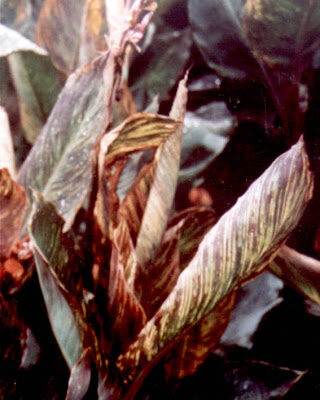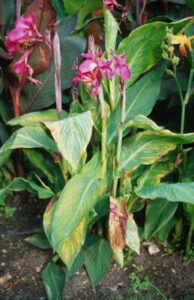What are canna viruses?
The Canna genus is susceptible to certain plant viruses, which can result in spotted or streaked leaves, in a mild form, but can ultimately result in stunted growth and twisted, distorted flowers and foliage.
How do you spot a virus attack?
In almost all cases, the leaf of the attacked plant takes on a different, but not uniform, colour. It discolours in very clear places, in sectors delimited by the veins. The discolouration follows a regular, checkerboard pattern. In addition, we sometimes speak of mosaic. The appearance of the leaf is also changed, it becomes thicker, smaller and a little embossed. The plant loses vigor and flowers less, if at all. It becomes susceptible to opportunistic diseases (powdery mildew).
Most often, the damage caused by viruses in plants is not very significant: growth delay, lower production, unsightly appearance, etc.
Unfortunately, plant viruses remain invisible to our eyes. They are only detected by a few symptoms that are easily confused with others. How to spot them, which ones are dangerous? This article attempts to take stock.
How many plant viruses are there?
However, viruses are more common in our cultivated plants than we suspect. 20 years ago, around 250 plant viruses were known. Now we are at almost 1,000! In the garden, some can be annoying, causing a lower harvest or visual damage. They rarely endanger a culture. But it is also to some of them that we owe many ornamental varieties with colored leaves. Viruses are therefore not all bad and their reproduction is worthy of a science fiction film!
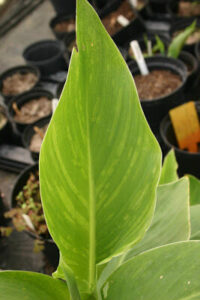 Symptoms
Symptoms
You may see the following symptoms:
- CaYMV causes streaks of pale tissue between the leaf veins. These later die, resulting in streaks of dead brown tissue
- BYMV causes a yellow mottling of the leaves
- CaYSV causes leaf-streaking similar to CaYMV
- Infections can result in stunted plants with distorted leaves
- ‘Breaks’ (white streaks) may occur in the flowers
When more than one virus is present in the same plant the symptoms may be more severe.
Control
Take care to buy healthy plants, avoiding any which are stunted or have suspicious colour patterns on leaves (though note that some cultivars have highly variegated leaves and it is very difficult to tell if these are infected without specialist tests)
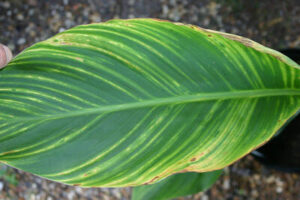 Do not propagate from any plant suspected of having virus infection, but destroy it before it can act as a source of infection for others.
Do not propagate from any plant suspected of having virus infection, but destroy it before it can act as a source of infection for others.
There are no chemical controls for virus infections. It is not practical to protect plants from the aphid vectors by using insecticides, however aphids are farmed by ants and it is practical to attempt to control ant populations in the garden.
Biology
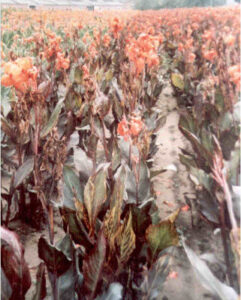 Plant viruses are extremely minute infectious particles consisting of a protein coat and a core of nucleic acid. They have no means of self-dispersal, but rely on various vectors (including humans) to transmit them from infected to healthy plants. Once viruses penetrate into the plant cells they take over the cells’ nucleic acid and protein synthesis systems and ‘hijack’ them to produce more virus.
Plant viruses are extremely minute infectious particles consisting of a protein coat and a core of nucleic acid. They have no means of self-dispersal, but rely on various vectors (including humans) to transmit them from infected to healthy plants. Once viruses penetrate into the plant cells they take over the cells’ nucleic acid and protein synthesis systems and ‘hijack’ them to produce more virus.
Viruses are frequently transmitted through propagated material but, depending on the virus, can also be transmitted via insect or mite vectors, pollen, mechanical transfer via contaminated hands and tools, or nematode vectors in the soil. Some viruses can be transmitted via seed, but generally these are a minority and therefore seed propagation is often a useful way to ensure virus free plant material.
The vector of CaYMV is not known, but it is thought it may be transmitted mechanically, for example on propagating tools. BYMV and CaYSV are vectored by aphids, which become contaminated with virus-containing sap when feeding on infected tissues, then fly to healthy plants and transfer the virus infection during feeding. BYMV may also be transmitted through infected seed, although some claim that only 4% of seeds from an infected plant also carry the virus, but some may find that frequency too high to take the risk of growing out seed from contaminated plants.
